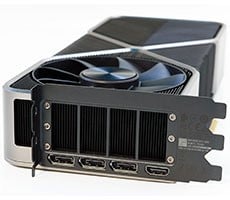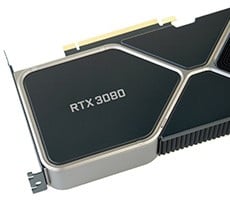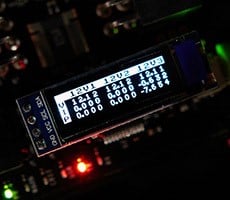NVIDIA nForce 680i LT SLI

Nvidia had been somewhat slow getting out of the gate with their initial Intel Core 2 compatible chipsets. Their first nForce 4 and nForce 5 series products for the Core 2 weren't very well received by enthusiasts, who mostly opted for more stable and less power hungry Intel based chipsets, unless Nvidia's SLI technology was an explicit requirement. While it has taken them a bit longer than expected to get their footing for this new processor architecture, it seems like Nvidia is truly hitting their stride with the nForce 600 series of products.
Currently, Nvidia is producing three chipset products in the nForce 600 lineup for Intel processors. At the high-end, you have the nForce 680i SLI chipset, which has all of the bells and whistles. Many of these high-end features were cut for the mid-range nForce 650i SLI platform, although it still offered SLI Multi-GPU support, albeit in a somewhat limited manner (only 8 x 8 lanes instead of a full 16 x 16). On the low-end, Nvidia is producing the nForce 650i Ultra, which drops SLI support from the mix, and hasn't been well adopted by motherboard makers and OEM markets. This is possibly due to the fact that the nForce 650i SLI has dropped in price significantly since launch, making it viable even for mid-range desktops who don't specifically need SLI.
However, while most have been satisfied with the tiered structure of Nvidia's nForce 600 series of products, there is a fairly large price gap sitting between the nForce 680i and nForce 650i. A quick scan on Newegg shows 680i boards ranging from $230 - $350, whereas nForce 650i boards are going for anywhere from $115 - $165, roughly half the prices of the 680i. While the nForce 650i has been popular with budget gamers, the 680i is often criticized for being over-priced in comparison to other high-end chipsets.
Today, Nvidia is looking to fill the gap between the 650i SLI and 680i SLI with a new product, the nForce 680i LT SLI. This chipset, which is a trimmed down version of the full-blown 680i SLI, is targeting the $199 price range "sweet spot" to compete against the Intel 975X chipset. This move allows Nvidia to counter Intel's offerings at every major price point. The first board hitting the market will be from eVGA, but it was designed by Nvidia themselves. We've managed to get our hands on a board for an evaluation and will showcase it here for you today.

Shipping Box - Front |

Shipping Box - Back |
|
|
|

"The Nvidia nForce 680i LT SLI "Designed by Nvidia" motherboard is engineered for the extreme gamer. Featuring award-winning Nvidia nForce 680i SLI performance at a great price, the Nvidia nForce 680i LT includes true dual x16 PCI Express slots with support for Nvidia SLI technology, and SLI-Ready memory with EPP for one-click access to enhanced memory settings. This motherboard delivers best-in-class overclocking capability, allowing extreme gamers to push their CPU and memory components to the next level. Coupled with tools like NV BIOS and Nvidia nTune utility for Microsoft Windows, the Nvidia nForce 680i LT SLI motherboard gives gamers complete control of their system."
|
|
The board we're looking at is designed by Nvidia, and manufactured by their partners, in this case eVGA. The board shares an identical core design to eVGA's previous nForce 680i platform, but with a few features missing in this incarnation of the nForce 680i LT chipset. Here are the fundamental differences between an nForce 680i SLI board and an nForce 680i SLI LT board.
No Triple PCIe x16 Card Support - Full nForce 680i platforms support dual PCI Express x16 cards along with a third PCI Express x16 slot (with x8 signaling). This slot is designed for dedicated PCI Express physics cards (which have still yet to hit the market) or an additional graphics card or RAID card. As utilization of this slot has been low, Nvidia decided to cut out this feature in order to cut down on costs. Most users will not miss this slot.
No Dual-LAN Support - The nForce 680i LT SLI chipset only supports one native Gigabit Ethernet port, as opposed to two on the 680i SLI. This also means that Nvidia's DualNet technology (which pairs multiple GigE links together) is out of the running on this chipset. The 680i LT SLI only supports a single Gigabit Ethernet port and Nvidia's FirstPacket priority optimization features. We should note that third party motherboard manufacturers could indeed provide dual-NICs, although they would have to rely on third party components connected to the PCIe/PCI bus, not native to the chipset. The majority of users only use one Gigabit Ethernet port, so again, this feature won't be missed by many.
No DDR2-1200 Support - This chipset only "officially" supports memory speeds up to 800 MHz, whereas the full 680i SLI chipset supported speeds up to 1200 MHz officially. Keep in mind, while this chipset only "officially" allows DDR speeds up to 800 MHz, the BIOS of this motherboard is fully equipped to run at much higher speeds, which we verified in testing.
No Board Level "Bling" - eVGA's full 680i SLI board featured a black PCB and diagnostic LED indicators, whereas this 680i board features no LED indicators and a standard green PCB.
Active Cooling - In our opinion, this may be the biggest notable change between the 680i SLI and the 680i LT SLI boards from eVGA. In order to cut down costs, eVGA/Nvidia removed the passive heatpipe based cooling of the two chipset components, opting instead for two small chipset coolers, each with fans. Now, the original 680i SLI's heatpipe cooler ran fairly hot so using the (optional) fan was more or less a requirement for power users. However, this board takes this efficient cooling system out of the mix, going for a more traditional route which is a noisier solution overall.
It's also important to note that all 680i LT SLI boards won't have active cooling - it's not a requirement, but eVGA is going this route. It's very possible that other board manufacturers will use passive heatpipe cooling solutions for their boards as well.






